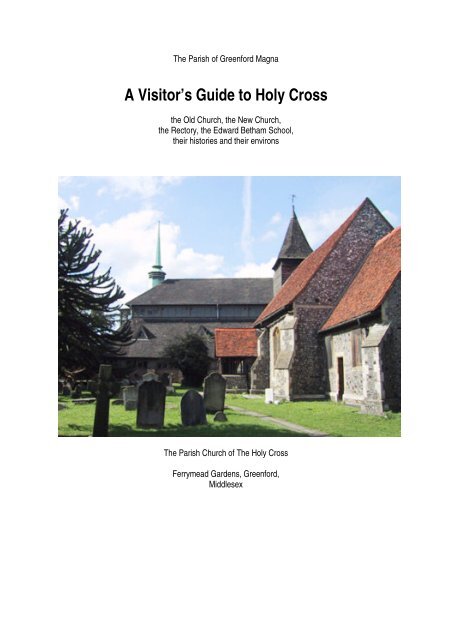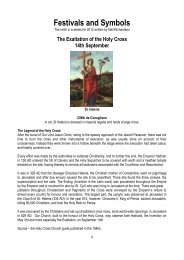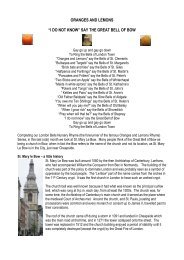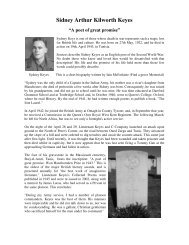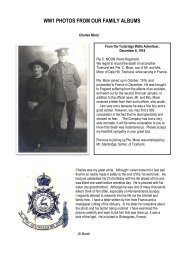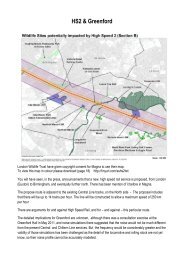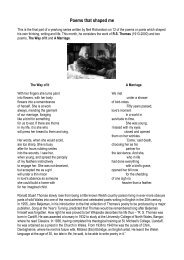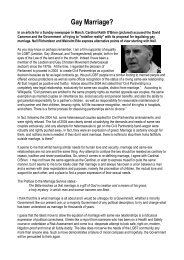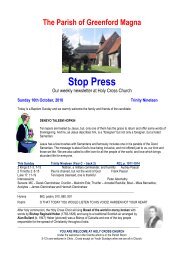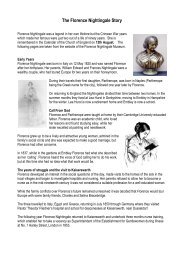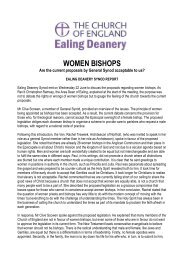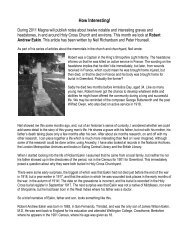A Visitor's Guide to Holy Cross - The Parish of Greenford Magna
A Visitor's Guide to Holy Cross - The Parish of Greenford Magna
A Visitor's Guide to Holy Cross - The Parish of Greenford Magna
Create successful ePaper yourself
Turn your PDF publications into a flip-book with our unique Google optimized e-Paper software.
<strong>The</strong> <strong>Parish</strong> <strong>of</strong> <strong>Greenford</strong> <strong>Magna</strong><br />
A Visi<strong>to</strong>r’s <strong>Guide</strong> <strong>to</strong> <strong>Holy</strong> <strong>Cross</strong><br />
the Old Church, the New Church,<br />
the Rec<strong>to</strong>ry, the Edward Betham School,<br />
their his<strong>to</strong>ries and their environs<br />
<strong>The</strong> <strong>Parish</strong> Church <strong>of</strong> <strong>The</strong> <strong>Holy</strong> <strong>Cross</strong><br />
Ferrymead Gardens, <strong>Greenford</strong>,<br />
Middlesex
Contents page<br />
1. An His<strong>to</strong>rical Background <strong>to</strong> <strong>Greenford</strong> <strong>Magna</strong> 1<br />
2. Map <strong>of</strong> the Former Middlesex 1<br />
3. Map <strong>of</strong> the Area round the Church Including the Station 2<br />
4. <strong>Greenford</strong> Life 3<br />
5. <strong>The</strong> <strong>Parish</strong> <strong>of</strong> <strong>Greenford</strong> <strong>Magna</strong> 7<br />
6. Architectural Introduction <strong>to</strong> the Old Church 8<br />
7. A Brief <strong>Guide</strong> <strong>to</strong> the Interior <strong>of</strong> the Old Church 9<br />
8. A Plan <strong>of</strong> the Old Church 9<br />
S<strong>to</strong>ne Font 10<br />
Pulpit 10<br />
Cos<strong>to</strong>n Memorial 10<br />
<strong>The</strong> Edward Betham Plaque 11<br />
<strong>The</strong> Chancel Arch 11<br />
<strong>The</strong> Gardiner Memorial 12<br />
<strong>The</strong> Stained Glass 12<br />
<strong>The</strong> Piscina 12<br />
9. <strong>The</strong> List <strong>of</strong> Rec<strong>to</strong>rs 13<br />
10. <strong>The</strong> Reserved Sacrament 13<br />
11. <strong>The</strong> Old Church Today 14<br />
12. <strong>The</strong> Reserved Sacrament 14<br />
13. <strong>The</strong> <strong>Holy</strong> <strong>Cross</strong> Bells and Bell Tower 15<br />
14. Architectural Introduction <strong>to</strong> the New Church 16<br />
Population Growth 16<br />
<strong>The</strong> Cambridge Connection 16<br />
Church Plate 17<br />
15. <strong>The</strong> Banners <strong>of</strong> the Instruments <strong>of</strong> the Passion 17<br />
16. <strong>The</strong> Stations <strong>of</strong> the <strong>Cross</strong> 17<br />
17. Tapestry – <strong>The</strong> Earth is the Lord's 18<br />
18. Laid-up Colours and Standards 18<br />
19. Home Guard Memorial 18<br />
20. Book <strong>of</strong> Remembrance 18<br />
21. <strong>The</strong> <strong>Holy</strong> <strong>Cross</strong> Churchyard 19<br />
22. <strong>The</strong> Rec<strong>to</strong>ry and Benefice Land 19<br />
23. Edward Betham and His School 20<br />
24. A Church <strong>of</strong> England <strong>Parish</strong> 22<br />
25. Various Policies 22<br />
26. Christian Nurture and Education 23<br />
27. <strong>The</strong> Records and Archives 24<br />
28. List <strong>of</strong> Articles S<strong>to</strong>len or Damaged 24<br />
29. <strong>The</strong> Invention and Exaltation <strong>of</strong> the <strong>Holy</strong> <strong>Cross</strong> 25<br />
5th edition, 2005<br />
<strong>The</strong> Rec<strong>to</strong>r and Churchwardens acknowledge with thanks the original research <strong>of</strong> Peter and Frances Hounsell<br />
which made the production <strong>of</strong> this booklet possible.<br />
1
Introduction<br />
An His<strong>to</strong>rical Background <strong>to</strong><br />
<strong>Greenford</strong> <strong>Magna</strong><br />
<strong>Greenford</strong> <strong>to</strong>day is a large suburb in the London Borough <strong>of</strong> Ealing, but for most <strong>of</strong> its his<strong>to</strong>ry, <strong>Greenford</strong> has<br />
been a tiny village with a very small population, isolated from surrounding areas and finding a living in labour<br />
on the land.<br />
People have lived in <strong>Greenford</strong> since at least 845 AD when there is a reference <strong>to</strong> Grenanforda in an Anglo-<br />
Saxon charter, in which the land was exchanged between Abbot Werhard and Werenth the Thane. <strong>The</strong> name<br />
indicates a place where the River Brent could be forded, or crossed, amidst green fields. <strong>The</strong> Manor <strong>of</strong><br />
<strong>Greenford</strong> was given by King Ethelred <strong>to</strong> the Abbey <strong>of</strong> Westminster and this was confirmed in 1066 by a<br />
charter <strong>of</strong> King Edward the Confessor. At the dissolution <strong>of</strong> the monasteries, the land was appropriated <strong>to</strong> the<br />
Diocese <strong>of</strong> Westminster in 1540, then the Diocese <strong>of</strong> London in 1550. <strong>The</strong> first priest whose name we know<br />
was Henry <strong>of</strong> Bayeux, who was instituted as parson <strong>of</strong> <strong>Greenford</strong> and Hanwell in 1183 by Gilbert Foliot, 56th<br />
Bishop <strong>of</strong> London. From 1326, we can trace a continuous list <strong>of</strong> Rec<strong>to</strong>rs, starting with Radbert de Saleby.<br />
<strong>The</strong> Domesday Book <strong>of</strong> 1068 AD notes that the land <strong>of</strong> <strong>Greenford</strong> <strong>Magna</strong> belonged <strong>to</strong> the Abbot <strong>of</strong><br />
Westminster, but does not mention a Church or a Priest. A Chapel was in existence in <strong>Greenford</strong> by 1157. It is<br />
not clear, however, when the first Church building was erected. Parts <strong>of</strong> the fabric <strong>of</strong> the existing "old" Church<br />
date from the 15th century, but these may well represent the rebuilding <strong>of</strong> an earlier structure rather than a<br />
completely new building. <strong>The</strong> discovery in the 1930's <strong>of</strong> a 14th century piscina in the wall <strong>of</strong> the chancel tends<br />
<strong>to</strong> support this interpretation.<br />
<strong>The</strong> fact that the Church was named <strong>The</strong> <strong>Holy</strong> <strong>Cross</strong> might indicate that a relic <strong>of</strong> the true cross was placed in<br />
this Church at the time <strong>of</strong> its earliest consecration.<br />
Old Middlesex<br />
2
<strong>Greenford</strong> <strong>to</strong>day with the position <strong>of</strong> the Churches arrowed<br />
3
<strong>Greenford</strong> Life<br />
Life in early <strong>Greenford</strong> revolved around the annual work <strong>of</strong> agriculture. Communication with the surrounding<br />
area and the wider world would have been through cart tracks and bridle ways. Travel would have been in the<br />
direction <strong>of</strong> Oxford <strong>to</strong> the west, Harrow <strong>to</strong> the north, and in particular, east <strong>to</strong>wards Westminster, where<br />
presumably, the Abbot's tithes were taken from time <strong>to</strong> time. To the south <strong>of</strong> <strong>Greenford</strong>, the journey <strong>to</strong><br />
Isleworth would have been alongside the River Brent which is a tributary <strong>of</strong> the Thames. Once there,<br />
<strong>Greenford</strong> people were eventually connected <strong>to</strong> the Pool <strong>of</strong> London and from thence, <strong>to</strong> the oceans <strong>of</strong> the<br />
world.<br />
Life in the village <strong>of</strong> <strong>Greenford</strong> must have remained fairly unadventurous and self-contained for several<br />
hundreds <strong>of</strong> years. Little by little, the influences <strong>of</strong> the outside world were <strong>to</strong> change all that. During the early<br />
Tudor period, a new Porch was added on the south face <strong>of</strong> the Church indicating the presence in the village <strong>of</strong><br />
both wealth and interest in the Church.<br />
<strong>Greenford</strong> people must have been aware <strong>of</strong> the decades <strong>of</strong> religious turmoil in the<br />
16th century. In 1534, King Henry VIII asserted his royal supremacy over the<br />
English Church and in the following year, Sir Thomas More and Bishop John<br />
Fisher were both executed. In 1536, Henry ordered the execution <strong>of</strong> Queen Anne<br />
Boleyn on a false charge <strong>of</strong> adultery, because she failed <strong>to</strong> produce a male heir <strong>to</strong><br />
the throne. Ironically, Anne was the mother <strong>of</strong> the future Elizabeth I, one <strong>of</strong><br />
England’s greatest monarchs. By 1539, Henry had arranged for the Dissolution <strong>of</strong><br />
the Monasteries and the fabric <strong>of</strong> English life was changed forever.<br />
Towards the end <strong>of</strong> his life, it became clear that Henry was <strong>to</strong> be succeeded by a<br />
10 year-old son, Edward VI, and England was plunged in<strong>to</strong> a 6 year Regency, during which Protestant voices<br />
were increasingly heard by those in power. Under their influence, the appearance and theology <strong>of</strong> the Church<br />
<strong>of</strong> England became increasingly distant from the theology and practice <strong>of</strong> Rome. It was during this period that<br />
the first Masses in English were heard in English churches, following the authorisation <strong>of</strong> Prayer books in 1549<br />
and 1552. <strong>The</strong> first Rec<strong>to</strong>r <strong>of</strong> <strong>Greenford</strong> <strong>Magna</strong> <strong>to</strong> say Mass in English would have been Henry Thorn<strong>to</strong>n,<br />
Rec<strong>to</strong>r from 1528-1554.<br />
When close <strong>to</strong> death, King Edward’s advisors persuaded him <strong>to</strong> name Lady Jane Grey, a cousin, as his<br />
successor. She reigned for just 6 days before there was a successful legal challenge from Mary, who became<br />
Queen Mary I and immediately res<strong>to</strong>red the Roman Catholic Church. John Feckenham, Rec<strong>to</strong>r between 1554<br />
and 1556, was caught up in the great controversies, retaining loyalty <strong>to</strong> the Roman Catholic Queen Mary I. He<br />
resigned as Rec<strong>to</strong>r <strong>of</strong> <strong>Greenford</strong> on his appointment by Queen Mary as Abbot <strong>of</strong> the newly re-established<br />
Abbey <strong>of</strong> St. Peter in Westminster. When Queen Mary died in 1558 and was replaced by her half sister Queen<br />
Elizabeth I, many churchmen hoped for a res<strong>to</strong>ration <strong>of</strong> relationships with the Pope. John Feckenham was<br />
imprisoned in the Tower from 1563-68 after speaking out against Queen Elizabeth’s supremacy in the Church.<br />
Despite the cruelties <strong>of</strong> the time, the reign <strong>of</strong> Queen Elizabeth I was a time <strong>of</strong> settlement and expansion,<br />
lasting for 44 years until 1603. <strong>The</strong> times saw a flourishing <strong>of</strong> the arts and sciences. Shakespeare wrote his<br />
plays which were performed on the stage <strong>of</strong> the Globe <strong>The</strong>atre at Bankside in Southwark. Michael Gardiner,<br />
who was Rec<strong>to</strong>r at this time, would have been the first Rec<strong>to</strong>r <strong>to</strong> use the new King James translation <strong>of</strong> the<br />
Bible when it became available in 1611.<br />
During the 17th century, England was again shaken by political and religious turmoil and the execution <strong>of</strong><br />
royalty. In 1642, a major Civil War broke out across the country and in 1649, King Charles I was beheaded<br />
and the Church disestablished. It was <strong>to</strong> be 11 years before the res<strong>to</strong>ration <strong>of</strong> the Monarchy in 1660. During<br />
most <strong>of</strong> this 11 year period, Oliver Cromwell ruled as Lord Protec<strong>to</strong>r and the country was governed as a<br />
Commonwealth. Edward Terry, who became Rec<strong>to</strong>r in 1629 simply remained in place, losing his <strong>of</strong>ficial title<br />
from 1649 until 1660, when he resumed it until his death in 1661.<br />
4
In the 18th century, the Revd. Edward Betham, Rec<strong>to</strong>r from 1769-1783 founded a Charity School which still<br />
exists, bearing his name. Succeeding Rec<strong>to</strong>rs are ex-<strong>of</strong>ficio Governors <strong>of</strong> the School and Trustees <strong>of</strong> the<br />
Betham Trust which administers the fund set up by Betham. <strong>The</strong> Annual Parochial Church Meeting elects<br />
members <strong>of</strong> the congregation as Foundation Governors <strong>of</strong> the School, thereby ensuring close links between<br />
<strong>Parish</strong> Church and School.<br />
During the 18th century, church life generally in England became increasingly moribund. <strong>The</strong> rural<br />
communities, such as <strong>Greenford</strong>, were slowly disintegrating as changes <strong>to</strong> the agricultural way <strong>of</strong> life led <strong>to</strong><br />
increasing numbers <strong>of</strong> labourers leaving the countryside and seeking employment in the rapidly growing<br />
<strong>to</strong>wns. Combination Laws were used <strong>to</strong> prevent labourers from working <strong>to</strong>gether <strong>to</strong> claim decent wages and<br />
conditions <strong>of</strong> work. In the cities, new technology was bringing dramatic developments as mills, foundries,<br />
fac<strong>to</strong>ries and mines created new wealth and a newly rich class <strong>of</strong> people.<br />
<strong>The</strong> social system was collapsing as increasing numbers <strong>of</strong> people became poverty-stricken and life became<br />
brutal and nasty. <strong>The</strong> Churches were unready and ill-equipped for dealing with such changes. In Oxford in<br />
1729, a group <strong>of</strong> young theological students formed themselves in<strong>to</strong> a group, later called Methodists, and they<br />
eventually <strong>to</strong>ok up the challenge <strong>to</strong> bring Christianity and political ideas <strong>to</strong> the poorer people <strong>of</strong> the <strong>to</strong>wns and<br />
cities.<br />
In 1804, the Padding<strong>to</strong>n Arm <strong>of</strong> the Grand Junction Canal<br />
was cut through <strong>Greenford</strong>, linking it both with the Midlands<br />
and with central London. From this beginning, <strong>Greenford</strong><br />
slowly changed from a rural backwater <strong>to</strong> a place <strong>of</strong> industry<br />
and housing. Starting with the first artificial dye works in<br />
England along the canal side, <strong>Greenford</strong> was destined <strong>to</strong><br />
attract many major companies looking for space <strong>to</strong> develop<br />
outside the cramped conditions <strong>of</strong> old London. <strong>The</strong> canal<br />
was used <strong>to</strong> transport coal from the Midlands and<br />
agricultural produce <strong>to</strong> Central London. Bricks made in<br />
nearby Hayes would pass through <strong>Greenford</strong> on their way<br />
<strong>to</strong> major building programmes in the area. <strong>The</strong> Grand<br />
Junction Canal forms part <strong>of</strong> the northern parish boundary<br />
<strong>to</strong>day.<br />
This process continued in 1904, when the Great Western Railway Company opened <strong>Greenford</strong> Station and<br />
provided a rail link <strong>to</strong> Ealing and the Padding<strong>to</strong>n terminal. Suburban housing was built in the years before the<br />
Great War and building continued during the 1920s and 1930s. In the 1930s, many more people moved <strong>to</strong><br />
<strong>Greenford</strong>. <strong>The</strong> hay fields rapidly became the streets in which were built houses for this influx <strong>of</strong> people,<br />
attracted by employment with Hoover, Aladdin, Rockware, Sandersons, J. Lyons and other famous names.<br />
Most <strong>of</strong> this housing is in the traditional semi-detached style and subsequent decades have seen further house<br />
building programmes, and this is likely <strong>to</strong> continue in<strong>to</strong> the 21st century, space permitting. Council houses and<br />
flats are fewer than the owner-occupied and there are no <strong>to</strong>wer blocks in <strong>Greenford</strong>.<br />
<strong>The</strong>se developments produced a population growth from less than 1,200 in 1921 <strong>to</strong> 15,000 in 1931. Several<br />
schools have been built in <strong>Greenford</strong> over the past 60 years, <strong>to</strong> join the Edward Betham School, in response <strong>to</strong><br />
the demands for education.<br />
<strong>The</strong> 19th century brought many changes <strong>to</strong> life in England. In the Church <strong>of</strong> England, the preaching in 1833 <strong>of</strong><br />
the Assize sermon by John Keble and the publication in 1841 <strong>of</strong> Tract 90 by John Henry Newman led <strong>to</strong> a reawakening<br />
within the Church <strong>of</strong> England <strong>of</strong> its proper place within the <strong>Holy</strong> Catholic and Apos<strong>to</strong>lic Church.<br />
This was followed by moves <strong>to</strong> res<strong>to</strong>re <strong>to</strong> the liturgy many <strong>of</strong> the practices and rituals <strong>of</strong> the Catholic Church<br />
which had been abandoned in the years following the Reformation, such as the wearing <strong>of</strong> vestments, altar<br />
5
crosses and candles, processions, incense and Confession. Even in such a back-water as <strong>Greenford</strong>, <strong>Holy</strong><br />
<strong>Cross</strong> Church was caught up in this movement and by 1923, Rec<strong>to</strong>r Thomas Scrut<strong>to</strong>n (Rec<strong>to</strong>r 1923-1934) was<br />
quoted in the Middlesex Gazette describing himself as a moderate Anglo-Catholic. Certainly, by the time <strong>of</strong><br />
Rec<strong>to</strong>r Donald Harris (1936-1945), <strong>Holy</strong> <strong>Cross</strong> was at the forefront <strong>of</strong> Catholic liturgical practices and a centre<br />
for new clergy who would come <strong>to</strong> <strong>Greenford</strong> as a training parish. At its hey-day, <strong>Greenford</strong> <strong>Magna</strong> had a<br />
Rec<strong>to</strong>r and six curates, all living in the Rec<strong>to</strong>ry!<br />
It is said that during the time <strong>of</strong> Rec<strong>to</strong>r Ronald Dix (1945-53) his learned brother and liturgical scholar, Dom<br />
Gregory Dix, was trying out many new ideas in liturgy at the newly built <strong>Holy</strong> <strong>Cross</strong> Church, some <strong>of</strong> which,<br />
like <strong>The</strong> Peace, are now commonplace activities in parish churches around the country.<br />
6<br />
In 1947, the Central Line was extended <strong>to</strong><br />
<strong>Greenford</strong> en route <strong>to</strong> Ruislip, and Central<br />
London became even more accessible for<br />
commuting. Nowadays, it is possible <strong>to</strong> be in<br />
Oxford Circus in 45 minutes via the Central<br />
Line, or if you prefer, <strong>to</strong> drive in the opposite<br />
direction and be in Oxford in 45 minutes.<br />
Two new roads were built <strong>to</strong> provide access for<br />
the rising population. <strong>The</strong> Western Avenue and<br />
<strong>Greenford</strong> Road were built from green fields. In<br />
the past 20 years, there have been two major<br />
road upgrades which have affected <strong>Greenford</strong>.<br />
In the 1970s, the A40 was widened and a flyover made <strong>to</strong> ease the flow <strong>of</strong> traffic east and west, in and out <strong>of</strong><br />
London and <strong>to</strong> Oxford and beyond. <strong>The</strong> <strong>Greenford</strong> Road was widened <strong>to</strong> take the bigger flow <strong>of</strong> traffic and give<br />
better access in a north-south direction. <strong>The</strong> original village lane, Oldfield Lane, was dissected by the A40,<br />
provided with an underpass and now seems tiny in comparison with its noisy neighbours.<br />
<strong>The</strong> continuing expansion <strong>of</strong> Heathrow<br />
airport provides <strong>Greenford</strong> residents with<br />
many job opportunities only 30 minutes<br />
away.<br />
<strong>Holy</strong> <strong>Cross</strong> Church is found just south <strong>of</strong><br />
the A40 at the junction <strong>of</strong> Ferrymead<br />
Gardens and Oldfield Lane South. <strong>The</strong><br />
immediate area around the Church is<br />
quiet and residential. To the north <strong>of</strong> the<br />
A40 is the industrial area and <strong>to</strong> the<br />
south, the <strong>Greenford</strong> shopping area<br />
known as <strong>Greenford</strong> Broadway. This<br />
reflects the three hamlets which made<br />
up the old village, with <strong>Greenford</strong> Green in the north, the area around the River Brent in the south, and the<br />
church in the centre, but quite distant from either extremity.<br />
All the mainstream Christian denominations have churches in <strong>Greenford</strong>. <strong>The</strong>re is a mixture <strong>of</strong> modern<br />
buildings, reflecting the his<strong>to</strong>ry <strong>of</strong> the suburb. <strong>The</strong> Roman Catholic Church <strong>of</strong> Our Lady <strong>of</strong> the Visitation is just<br />
south <strong>of</strong> the <strong>Greenford</strong> Broadway, on <strong>Greenford</strong> Road. <strong>Greenford</strong> Baptist Church is in Beechwood Avenue.<br />
<strong>Greenford</strong> Methodist Church is on Ruislip Road West. <strong>The</strong> Salvation Army Citadel is on Cos<strong>to</strong>n's Lane, at the<br />
junction with <strong>Greenford</strong> Road.
In 1998, the Church <strong>of</strong> St. Edward, King and Confessor, then a daughter-church <strong>of</strong> the <strong>Parish</strong>, was joined by<br />
the Perivale Park United Reformed Church in a newly refurbished building and a new church on Suez Avenue<br />
on the Medway Estate. <strong>The</strong> two congregations are now worshipping <strong>to</strong>gether and moving <strong>to</strong>wards a unified<br />
Christian presence on the Medway estate under the name <strong>of</strong> <strong>The</strong> <strong>Holy</strong> Trinity and since June, 2005, in the<br />
parish <strong>of</strong> Perivale.<br />
<strong>Greenford</strong>, like other parts <strong>of</strong> the London Borough <strong>of</strong> Ealing, has seen a significant change in its population<br />
over the past 40 years, in line with general migration patterns. It has a substantial population from overseas,<br />
drawn from Asia, Africa, the Caribbean and Europe. Since the expansion <strong>of</strong> the European Community in May<br />
2004, migrants from the new accession countries and especially Poland have found their way <strong>to</strong> <strong>Greenford</strong> in<br />
significant numbers. <strong>The</strong>se and other demographic changes have produced a suburb and a Borough with a<br />
wide variety <strong>of</strong> cultures and religions. Many people <strong>of</strong> other world faiths live in <strong>Greenford</strong>, but until recently, the<br />
only place <strong>of</strong> worship for other world faiths here was the Synagogue. Due <strong>to</strong> declining number <strong>of</strong> Jewish<br />
residents in <strong>Greenford</strong>, the Jewish community de-commissioned their Synagogue on Sunday, 23rd January,<br />
2000 and on Sunday 5th November, 2000, the building was re-opened as the Shree Jalaram Mandir (London),<br />
a Hindu Temple. <strong>The</strong>re is a wide range <strong>of</strong> Mosques, Mandirs and Gurdwaras <strong>to</strong> visit in nearby Southall.<br />
<strong>Greenford</strong> has greatly changed since its early<br />
beginnings. As the population grew in the 1930s,<br />
the ancient <strong>Parish</strong> <strong>of</strong> <strong>Greenford</strong> <strong>Magna</strong> – with the<br />
highest population in the land at that time – was<br />
divided in<strong>to</strong> three separate parishes. In the north,<br />
a new parish was formed with the building <strong>of</strong> All<br />
Hallows Church. In the south, the southern parts<br />
<strong>of</strong> <strong>Greenford</strong> were joined with parts <strong>of</strong> Southall <strong>to</strong><br />
form Christ the Redeemer <strong>Parish</strong>. Even so, the<br />
<strong>Parish</strong> Church was still <strong>to</strong>o small for the<br />
population, so in 1939 the Rec<strong>to</strong>r and<br />
parishioners under<strong>to</strong>ok <strong>to</strong> build a New Church.<br />
<strong>The</strong> problems they experienced were immediately exacerbated by the declaration <strong>of</strong> war against Germany.<br />
After a faltering start, the project was successfully completed <strong>to</strong> a design by Sir Albert Richardson, and with<br />
the magnificent result visible <strong>to</strong>day. <strong>The</strong> Old Church is listed by English Heritage as Grade I and the New<br />
Church as II* making these buildings not only special <strong>to</strong> the people <strong>of</strong> <strong>Greenford</strong>, but giving them a special<br />
place in the heritage <strong>of</strong> the nation.<br />
<strong>Holy</strong> <strong>Cross</strong> Old Church and New Church are used by the congregation and people <strong>of</strong> <strong>Greenford</strong> in a variety <strong>of</strong><br />
ways <strong>to</strong>day, reflecting modern thinking about church buildings. <strong>The</strong> Old Church is chosen when the number<br />
attending a service is expected <strong>to</strong> be less than 100, and the New Church is ideal for larger gatherings, such as<br />
the Midnight Mass <strong>of</strong> Christmas and Education Sunday. Weddings look lovely in either setting.<br />
<strong>The</strong> <strong>Parish</strong> Room at the rear <strong>of</strong> the New Church building is used regularly by <strong>Holy</strong> <strong>Cross</strong> Play Group, the 1st<br />
<strong>Greenford</strong> <strong>Guide</strong>s and Brownies and private individuals may hire it for parties and receptions. In 1976, during<br />
the time <strong>of</strong> Rec<strong>to</strong>r Malcolm Smart (1975-1982), the Chancellor <strong>of</strong> the Diocese <strong>of</strong> London ruled that the New<br />
Church was a dual-purpose building, thereby permitting the Rec<strong>to</strong>r and Wardens <strong>to</strong> allow its use for secular<br />
purposes such as dances, theatrical productions, fairs, parties, concerts and the like. <strong>The</strong> church has taken full<br />
advantage <strong>of</strong> this provision, using the New Church for Barn Dances, Christmas Craft Fayres, Pancake Races,<br />
<strong>Parish</strong> Parties, Pan<strong>to</strong>mimes, International Food evenings and many more community events. Since 1997,<br />
Capital Concert Brass Band (formerly the Hanwell Band) has made its home within the Church and uses it for<br />
regular rehearsals.<br />
7
Since the 1990s, the old altar area <strong>of</strong> the New Church has been transformed in<strong>to</strong> a stage for Community<br />
Pan<strong>to</strong>mimes, in which Scouts, <strong>Guide</strong>s, congregation members and friends <strong>of</strong> the church have combined <strong>to</strong><br />
produce very successful and well-attended amateur performances, many <strong>of</strong> which are written by local people.<br />
In the New Church, the visi<strong>to</strong>r will be impressed by 10 Banners <strong>of</strong> the Instruments <strong>of</strong> the Passion <strong>of</strong> Our Lord<br />
Jesus Christ, designed and executed in batik by Ginette Gillard specially for the church in 1989. In addition,<br />
there are 14 Stations <strong>of</strong> the <strong>Cross</strong>, specially designed and created for the church in 1996 by Cate Temple<strong>to</strong>n.<br />
Both Ginette Gillard and Cate Temple<strong>to</strong>n are local <strong>Greenford</strong> people (although Cate has now returned <strong>to</strong> her<br />
native Scotland) and it is a particular pleasure <strong>to</strong> house such striking and original works <strong>of</strong> art by local artists.<br />
It is planned <strong>to</strong> try <strong>to</strong> protect and enhance the Old Church porch with glazing in the future, hopefully with<br />
artistic designs which will be pleasing for this and succeeding generations.<br />
<strong>The</strong> general use <strong>of</strong> the New Church makes it a busy and happy centre <strong>of</strong> community life, and the congregation<br />
welcome this, despite the extra cleaning it creates! <strong>The</strong> people <strong>of</strong> <strong>Greenford</strong> value both the Church buildings<br />
and the Christian faith which they represent. Times change. Our vision <strong>of</strong> life changes. Our use <strong>of</strong> the building<br />
changes <strong>to</strong>o. But underneath it all lies our faith in the love <strong>of</strong> God which Jesus Christ died on the <strong>Holy</strong> <strong>Cross</strong> <strong>to</strong><br />
proclaim.<br />
<strong>The</strong> <strong>Parish</strong> <strong>of</strong> <strong>Greenford</strong> <strong>Magna</strong><br />
is a constituent parish <strong>of</strong> the Church <strong>of</strong> England and in the Diocese <strong>of</strong> London.<br />
Everyone who lives within the legal borders <strong>of</strong> the parish or who are enrolled on the<br />
Church Elec<strong>to</strong>ral Roll have access <strong>to</strong> their parish church and are entitled <strong>to</strong> the<br />
services <strong>of</strong> the clergy. Members <strong>of</strong> the Elec<strong>to</strong>ral Roll elect a Parochial Church Council<br />
annually, <strong>to</strong> lead the mission <strong>of</strong> the Church with the Rec<strong>to</strong>r and Churchwardens.<br />
<strong>The</strong> congregation is made up <strong>of</strong> those people who present themselves on Sunday<br />
mornings, and everyone is welcome <strong>to</strong> participate in worship, social activities, study<br />
groups, and all other activities, including children's activities, no matter what their<br />
background, and no matter at what point on the journey <strong>of</strong> faith they find themselves.<br />
New people are frequently welcomed and quickly find place within our parish life, finding for their skills and<br />
gifts a satisfying and fulfilling outlet.<br />
<strong>The</strong> New Church arranged for a pan<strong>to</strong> production<br />
8
Architectural Introduction<br />
<strong>to</strong> the Old Church<br />
Of the 237 Middlesex churches surveyed by<br />
the London and Middlesex Archaeological<br />
Society in 1982, <strong>Holy</strong> <strong>Cross</strong> Old Church is one<br />
<strong>of</strong> only 30 which may be described as<br />
medieval, due <strong>to</strong> the origin <strong>of</strong> the main fabric.<br />
<strong>The</strong> Old Church has been rebuilt and altered<br />
many times in its long his<strong>to</strong>ry. It is not sure<br />
when the first structure was erected but there<br />
are traces <strong>of</strong> 14th century work in the present<br />
building. At the end <strong>of</strong> the 15th century the<br />
church was rebuilt and the oldest surviving<br />
parts <strong>of</strong> the present building date from this<br />
period. <strong>The</strong>se are the nave, the porch and the<br />
timbers which support the <strong>to</strong>wer at the west<br />
end. <strong>The</strong> building is constructed <strong>of</strong> s<strong>to</strong>ne and<br />
an exterior facing <strong>of</strong> flint was added in the<br />
1870s. <strong>The</strong> ro<strong>of</strong>s <strong>of</strong> the nave and chancel are<br />
tiled whilst the <strong>to</strong>wer is covered with cedar<br />
shingles.<br />
In the 17th century, the chancel was rebuilt<br />
and Commandment Board was hung over the<br />
chancel arch. It is possible that the gallery was<br />
built at the same time.<br />
In 1871, a major alteration was made when the<br />
chancel arch was taken down and rebuilt as it<br />
is <strong>to</strong>day, leaving the old timbers visible. Tiles were laid on the nave floor.<br />
In 1913, the <strong>to</strong>wer was substantially res<strong>to</strong>red.<br />
<strong>The</strong> last major res<strong>to</strong>ration <strong>to</strong>ok place in the 1950s after the Church had been closed and considered for<br />
possible demolition in the light <strong>of</strong> the New Church which had been completed in 1941. Following this work, the<br />
church was re-consecrated in 1956.<br />
In 2001, substantial remedial work was undertaken <strong>to</strong> check the effects <strong>of</strong> the ro<strong>of</strong> in pushing the walls<br />
outwards.<br />
9
A BRIEF GUIDE<br />
TO THE INTERIOR<br />
ENTER BY THE 16th CENTURY PORCH<br />
(see the plan below)<br />
<strong>The</strong> Porch (1)<br />
In the past, the Church porch was used for public and <strong>of</strong>ficial<br />
business such as exchanging marriage vows and for<br />
elections, and it is still used for posting notices. Note the ro<strong>of</strong><br />
bosses depicting the three nails and five wounds <strong>of</strong> the<br />
crucifixion – suitable for a Church named <strong>The</strong> <strong>Holy</strong> <strong>Cross</strong>.<br />
<strong>The</strong> doorway is in the perpendicular style and although<br />
wearing away it has some interesting carving between the<br />
arch and the square head.<br />
Plan <strong>of</strong> the Old Church<br />
10
IN THE NAVE<br />
Originally, it was cus<strong>to</strong>m for churches <strong>to</strong> have no seating. Pews were introduced by the 17th century. <strong>Holy</strong><br />
<strong>Cross</strong> has had two sets <strong>of</strong> pews, both now removed (one set is now in St. Mary, Northolt) and in the 1950s,<br />
chairs were installed as part <strong>of</strong> the renovations. At this time, the panelled ceiling was removed, revealing the<br />
oak timbers.<br />
<strong>The</strong> S<strong>to</strong>ne Font (2)<br />
<strong>The</strong> font is dated 1638 and was the gift <strong>of</strong> Frances Cos<strong>to</strong>n, the oldest<br />
daughter <strong>of</strong> Simon Cos<strong>to</strong>n. <strong>The</strong> oak font cover was s<strong>to</strong>len during the<br />
1980s.<br />
<strong>The</strong> Pulpit (3)<br />
<strong>The</strong> present pulpit was constructed from part <strong>of</strong> the 1930s oak screen.<br />
<strong>The</strong> rail from this screen is now above the chancel arch as part <strong>of</strong> the<br />
rood. <strong>The</strong> Rood and the Shrine <strong>to</strong> the Blessed Virgin Mary were added<br />
at the time <strong>of</strong> the 1950s res<strong>to</strong>ration work.<br />
<strong>The</strong> Cos<strong>to</strong>n Memorial (4)<br />
<strong>The</strong> memorial is <strong>to</strong> Bridget, wife <strong>of</strong> Simon Cos<strong>to</strong>n, and depicts the five daughters and baby son, John, who is<br />
being suckled by his mother. Bridget died at the age <strong>of</strong> 36 in 1637. <strong>The</strong> monument is signed by H & M Moyer.<br />
<strong>The</strong> monument was subjected <strong>to</strong> the theft <strong>of</strong> the two oldest daughters in July, 1996. Replicas were installed in<br />
1997.<br />
11
Edward Betham Plaque (5)<br />
Note the Plaque mounted on the south wall, commemorating the gift <strong>of</strong> money by Rec<strong>to</strong>r Edward Betham<br />
(1769-1783) and the foundation <strong>of</strong> his Charity School, now the Edward Betham Church <strong>of</strong> England Primary<br />
School (also see page 20).<br />
AT THE CHANCEL<br />
<strong>The</strong> Chancel Arch (6)<br />
1780<br />
EDW D. BETHAM<br />
Rec<strong>to</strong>r <strong>of</strong> this Parifh, built a Charity School<br />
with a Houfe for the Mafter & Miftrefs<br />
& endowed it with £1600 Bank S<strong>to</strong>ck.<br />
£10 part <strong>of</strong> the Dividends <strong>to</strong> go <strong>to</strong>wards<br />
Cloathing Ten Poor aged Men & Women<br />
<strong>of</strong> this Parifh, who fhould attend<br />
the Sacrament on Xmafs Day:<br />
£30 <strong>to</strong> the Mafter for Instructing 30<br />
Poor Boys & Girls, <strong>to</strong> Read, Write,<br />
Caft accompts, & Know the Principles<br />
<strong>of</strong> the Xtian Religion;<br />
the Girls <strong>to</strong> be Taught alfo<br />
<strong>to</strong> Work, Sew and Knit;<br />
£30 in Coals for the School;<br />
Other part in Cloathing the Children,<br />
& the Remainder in Repairing<br />
the School & Houfe, & in buying<br />
Spelling,-Prayer-Books, Teftaments, &c.<br />
Inroll’d in Chancery Nov.16 th. 1780<br />
<strong>The</strong> original arch was repaired and substantially replaced in 1871. A plaque on the wall commemorates the<br />
work.<br />
<strong>The</strong> 17th century Commandment Board was removed and now may be seen as part <strong>of</strong> the reredos behind the<br />
altar. <strong>The</strong> altar rails are 17th century and the badly vandalised brass candelabra has the inscription:<br />
<strong>The</strong> gift <strong>of</strong> Arthur Boldero <strong>of</strong> Brentford <strong>to</strong> the parish <strong>of</strong> <strong>Greenford</strong> <strong>Magna</strong> in Middx. April, 1709.<br />
Simon Ravenor Yeoman then Churchwarden<br />
12
<strong>The</strong> Gardiner Memorial (7)<br />
In the chancel, also note the excellent memorial <strong>to</strong> Michael Gardiner (Rec<strong>to</strong>r 1584-1623) and his wife,<br />
kneeling.<br />
On the chancel walls and floors, there are also memorials <strong>to</strong> other former Rec<strong>to</strong>rs including John Castell<br />
(1661), Thomas Barrow (1804) and Arthur Beard (1874), as well as some notable parishioners including<br />
William Millett (1663), the Terry family (1665), members <strong>of</strong> the Ravenor family, and Capt. & Mrs. Bennett<br />
(1856).<br />
<strong>The</strong> Stained Glass in the Chancel<br />
<strong>The</strong> stained glass in the Chancel is mostly from King's College, Cambridge, and was installed in 1925. <strong>The</strong><br />
glass is 16th century and mostly heraldic, incorporating the arms <strong>of</strong> Henry VIII and Katherine <strong>of</strong> Aragon as well<br />
as those <strong>of</strong> E<strong>to</strong>n College and King's College. <strong>The</strong>re are some fragments <strong>of</strong> Flemish work dating from the 14th<br />
century, including the head <strong>of</strong> a <strong>to</strong>nsured clerk or religious and the head <strong>of</strong> a saint.<br />
<strong>The</strong> Piscina (8)<br />
Rediscovered in 1934, the 14th century piscina or wall basin would have been used in the cleansing <strong>of</strong> the<br />
sacred vessels <strong>of</strong> the Mass. This piscina indicates further the original foundation date <strong>of</strong> the building.<br />
Alongside the piscina is another recess in the wall, possibly used <strong>to</strong> house the <strong>Holy</strong> Oils.<br />
List <strong>of</strong> Rec<strong>to</strong>rs <strong>of</strong> the <strong>Parish</strong> (9)<br />
Note the list <strong>of</strong> Rec<strong>to</strong>rs from 1326 AD until the present day<br />
on the north west wall <strong>of</strong> the nave. <strong>The</strong> gap between 1649<br />
and 1660 represents the period called <strong>The</strong> Commonwealth.<br />
In 1649, King Charles I was beheaded and the Church<br />
disestablished. During this period, Oliver Cromwell declared<br />
himself Protec<strong>to</strong>r <strong>of</strong> England, Scotland and Ireland and ruled<br />
until his death in 1658 when his son Richard <strong>to</strong>ok over until<br />
the res<strong>to</strong>ration <strong>of</strong> the monarchy in 1660. <strong>The</strong> Reverend<br />
Edward Terry who appears as Rec<strong>to</strong>r from 1629-1649 and<br />
again in 1660, was the same person, who simply resumed<br />
his <strong>of</strong>ficial post as Rec<strong>to</strong>r with the re-establishment <strong>of</strong> the<br />
Church <strong>of</strong> England in 1660 after the Protec<strong>to</strong>rate <strong>of</strong> Oliver<br />
Cromwell was ended.<br />
13
Rec<strong>to</strong>rs <strong>of</strong> <strong>Greenford</strong><br />
In 1183, Henry <strong>of</strong> Bayeux was appointed Rec<strong>to</strong>r <strong>of</strong> <strong>Greenford</strong> and Hanwell by Gilbert Foliot,<br />
56th Bishop <strong>of</strong> London. <strong>The</strong>reafter, it is possible <strong>to</strong> trace Rec<strong>to</strong>rs <strong>of</strong> <strong>Greenford</strong> continuously from 1326.<br />
1326 Radbert de Saleby 1649<br />
1330 Richard de Nor<strong>to</strong>n 1660 Edward Terry<br />
1363 John de Coringham 1661 John Castell<br />
Walter Palmer 1686 Mathias Earbery<br />
1383 John Lyn<strong>to</strong>n 1688 John Delahay<br />
1386 John Catelin 1730 William Campbell<br />
1390 John Seyntin 1769 Edward Betham<br />
1401 John Ringbell 1783 William Paddon<br />
1407 Stephen Lathe 1797 John Maule<br />
1409 Robert Halstead 1804 Thomas Barrow<br />
1410 John Smith 1822 Edward Polehamp<strong>to</strong>n<br />
John Wrastlingworth 1830 Henry Slingsby<br />
1418 John Chandler 1832 John Tomkyns<br />
Simon Hert 1849 J.C. Middle<strong>to</strong>n<br />
1452 Thomas Wegge 1874 Arthur Beard<br />
1473 Henry Aynesworth 1890 Henry Biscoe<br />
1489 Gregory Wat 1912 W.H. Ogle-Skan<br />
Thomas Symond 1915 Edmund Swain<br />
1518 Thomas Cot<strong>to</strong>n 1923 Tom Scrut<strong>to</strong>n<br />
1528 Henry Thorn<strong>to</strong>n 1934 Cecil Clarke<br />
1554 John Feckenham 1936 Donald Harris<br />
1556 Thomas Barnard 1945 Ronald Dix<br />
1558 Robert Cosen 1953 Frank Towndrow<br />
Thomas Thorn<strong>to</strong>n 1962 Brian Oman<br />
1560 William Whitlock 1975 Malcolm Smart<br />
1584 Michael Gardiner 1982 Neil Richardson<br />
1629 Edward Terry<br />
Father Donald Harris<br />
Rec<strong>to</strong>r from 1936-1945, under whose leadership the <strong>Holy</strong> <strong>Cross</strong> New Church was planned and constructed<br />
despite the added problems and constraints <strong>of</strong> wartime<br />
14
<strong>The</strong> Old Church Today<br />
Continuity <strong>of</strong> worship<br />
In continuity with its 600 year his<strong>to</strong>ry, the Old Church is still used for prayer and worship daily. <strong>The</strong>re is a<br />
pattern <strong>of</strong> worship which includes said Masses at 7am and Morning Prayer. Precise details are published in<br />
the porch and newsletter.<br />
<strong>The</strong> church seats about 100 people and is a favourite setting for weddings, and for funerals. It is very popular<br />
for special occasions such as the Christmas Carol Service.<br />
Both the Churches are frequently visited by school children from various local schools, in search <strong>of</strong> material for<br />
their studies in Religious Education and Local His<strong>to</strong>ry.<br />
Reservation <strong>of</strong> the Blessed Sacrament<br />
When the New Church was re-ordered in 1978, the practice <strong>of</strong> reserving the Sacrament in that church was<br />
discontinued and from that date the Blessed Sacrament has been reserved in the Old Church in an Aumbry in<br />
the Chancel, just beneath the Gardiner Memorial (7). <strong>The</strong>re is a light burning permanently <strong>to</strong> alert the visi<strong>to</strong>r <strong>to</strong><br />
the presence <strong>of</strong> the Blessed Sacrament and <strong>to</strong> symbolise the Light <strong>of</strong> Christ.<br />
<strong>The</strong>re are two reasons for reserving the Blessed Sacrament.<br />
First, it is <strong>to</strong> make the Church a place for the adoration <strong>of</strong> Jesus Christ in the Sacrament <strong>of</strong> the Mass. His Real<br />
Presence continually inspires the Church <strong>to</strong> devotion and Christian endeavour.<br />
Secondly, those who are sick or dying may receive the <strong>Holy</strong> Communion from the Reserved Sacrament, thus<br />
uniting them with the whole congregation who met on the previous Sunday <strong>to</strong> celebrate the Mass.<br />
It is cus<strong>to</strong>mary <strong>to</strong> observe respect for the Blessed Sacrament.<br />
15
<strong>The</strong> Bells and the Bell Tower<br />
<strong>The</strong> first Christian writer <strong>to</strong> mention bells frequently was called St. Gregory <strong>of</strong> Tours (c. 585). Tours is a <strong>to</strong>wn in<br />
the north west <strong>of</strong> France. Bells were used a lot in Ireland from the 6th century. <strong>The</strong> famous bell <strong>of</strong> St. Patrick is<br />
said <strong>to</strong> survive in Dublin. Bells were used in Scotland from the 6th century and in England from the 7th<br />
century. <strong>The</strong>y came in<strong>to</strong> general use in English Churches in the 8th century. From this time, bells were always<br />
blessed by a Bishop and splashed with <strong>Holy</strong> Water and anointed with the Oil <strong>of</strong> Chrism. This was called the<br />
Baptism <strong>of</strong> Bells.<br />
Church Bells are rung for a variety <strong>of</strong> reasons, including:<br />
a) drawing attention <strong>of</strong> parishioners <strong>to</strong> the start <strong>of</strong> <strong>The</strong> Mass;<br />
b) marking important national occasions, such as a Coronation, or vic<strong>to</strong>ry in a battle;<br />
c) bells are <strong>to</strong>lled (rung solemnly and slowly) <strong>to</strong> mark the death (or passing) <strong>of</strong> a parishioner or the start <strong>of</strong> a<br />
funeral service (hence the phrase passing bell);<br />
d) for the ringing <strong>of</strong> <strong>The</strong> Angelus – a special prayer <strong>to</strong> remind people <strong>of</strong> the Incarnation <strong>of</strong> Jesus. Other prayers<br />
are also associated with the ringing <strong>of</strong> bells;<br />
e) in some Churches, the bell is rung when the priest elevates the Host and the Chalice in the Eucharistic<br />
Prayer so that the whole neighbourhood knows what is happening.<br />
Bells were housed in specially designed <strong>to</strong>wers, Campaniles, and these could either be added on <strong>to</strong> the end <strong>of</strong><br />
a Church or built separately, but nearby.<br />
<strong>The</strong> <strong>Holy</strong> <strong>Cross</strong> Bell Tower<br />
<strong>Holy</strong> <strong>Cross</strong> <strong>to</strong>wer is built on <strong>to</strong> the west end <strong>of</strong> the Church. It is a<br />
wooden-framed and clad <strong>to</strong>wer, supporting the bell turret. <strong>The</strong> oak<br />
bell-frame dates from the 15th century.<br />
<strong>The</strong> <strong>Holy</strong> <strong>Cross</strong> Bells<br />
a) the largest (5 cwt 1 qr) by William Culverden, c. 1510, has the<br />
Latin inscription: Sancta Anna ora pro nobis which means in<br />
English: Saint Anne pray for us<br />
b) an undated bell (2 cwt 3qrs) from the 15th century<br />
c) bell (3cwt 2qrs) dated 1699 by William Eldridge I <strong>of</strong> Chertsey<br />
<strong>The</strong> oaken bell frame is 500 years old. It is thought that it was made<br />
in the carpenter's workshop, dis-assembled and carried in<strong>to</strong> the<br />
<strong>to</strong>wer, before being re-assembled in the <strong>to</strong>wer.<br />
Change ringing is not possible at <strong>Holy</strong> <strong>Cross</strong>. <strong>The</strong> Tower must be<br />
very strong <strong>to</strong> withstand the vibrations and swaying which the bell<br />
sound produces. Our Tower was built long before the invention <strong>of</strong><br />
Change ringing, and so we must be satisfied with just striking the bells.<br />
<strong>The</strong> Tower is electrically lit but <strong>to</strong> visit <strong>Holy</strong> <strong>Cross</strong> Bell Tower requires climbing two ladders without safety rails.<br />
It is also very dusty!<br />
<strong>The</strong> wearing <strong>of</strong> trousers is advised for ladies.<br />
16
Architectural Introduction<br />
<strong>to</strong> the New Church<br />
Population growth<br />
Due <strong>to</strong> the huge increase in the population <strong>of</strong> <strong>Greenford</strong><br />
during the 1920 and 30s, it was decided <strong>to</strong> build a New<br />
<strong>Holy</strong> <strong>Cross</strong> Church. Fortunately, it was also decided <strong>to</strong><br />
retain the Old Church, rather than demolish it in favour<br />
<strong>of</strong> the new. <strong>The</strong> Foundation S<strong>to</strong>ne (in the external wall<br />
on the south east corner) was laid by the Provost <strong>of</strong><br />
King's College, Cambridge, in the presence <strong>of</strong> the<br />
Bishop <strong>of</strong> London on 10th July, 1939, and despite the<br />
onset <strong>of</strong> the war against Germany, the church was<br />
completed and opened two years later. Legally, the<br />
New Church is regarded as an extension <strong>of</strong> the Old<br />
Church, which bears the same name, although licensed<br />
separately for <strong>Holy</strong> Matrimony.<br />
<strong>The</strong> New Church stands at right angles <strong>to</strong> the Old Church. It was designed by Pr<strong>of</strong>essor Sir Albert Richardson<br />
who already had associations with the parish due <strong>to</strong> his involvement with the renovations <strong>of</strong> the Old Church.<br />
<strong>The</strong> architect had recently visited Nieuwe Kerk in <strong>The</strong> Hague, and had been inspired by the timber ro<strong>of</strong> beams.<br />
<strong>The</strong> shape <strong>of</strong> the New Church resembles that <strong>of</strong> a Tithe Barn with its low walls and large ro<strong>of</strong>. Inside, the ro<strong>of</strong><br />
is supported by large red pine timbers from British Columbia.<br />
<strong>The</strong> New Church interior was originally designed in the traditional way with a High Altar in the Chancel and<br />
rows <strong>of</strong> chairs in the nave. <strong>The</strong> original furnishings on the altar included six huge candles and a Tabernacle,<br />
backed by a massive red back drop. In 1976, the Rec<strong>to</strong>r and Churchwardens successfully petitioned the<br />
Chancellor <strong>of</strong> the Diocese for a Faculty <strong>to</strong> re-order the interior as it is <strong>to</strong>day. At the same time, the New Church<br />
was declared a dual-purpose building and this makes it possible for it <strong>to</strong> be used for plays, dances,<br />
entertainments and social events.<br />
<strong>The</strong> Cambridge Connection<br />
<strong>The</strong> reason for the Provost <strong>of</strong> King's College, Cambridge, being involved with the Foundation S<strong>to</strong>ne <strong>of</strong> the<br />
New Church is that King's are the Patrons <strong>of</strong> the<br />
Living <strong>of</strong> <strong>Greenford</strong> <strong>Magna</strong>. In the case <strong>of</strong> the <strong>Parish</strong><br />
<strong>of</strong> <strong>Greenford</strong> <strong>Magna</strong>, the Advowson, or legal right <strong>to</strong><br />
present a priest <strong>to</strong> the Bishop for Institution as Rec<strong>to</strong>r,<br />
is owned by the Provost and Fellows <strong>of</strong> King's<br />
College, Cambridge. Private Patronage is still valued<br />
in the Church <strong>of</strong> England as it provides for a variety <strong>of</strong><br />
ways in which appointments can be made, thereby<br />
avoiding an over-prescriptive use <strong>of</strong> authority by the<br />
Bishops. In the past, private patronage has sheltered<br />
some excellent priests who would otherwise have<br />
fallen foul <strong>of</strong> the prevailing, but uncongenial climate <strong>of</strong><br />
opinion in the Church.<br />
17
<strong>The</strong> Church Plate<br />
<strong>The</strong> Banners <strong>of</strong> the Instruments <strong>of</strong> the Passion<br />
Among the plate, there is a Charles I chalice with a very deep bowl<br />
and a paten with a foot. <strong>The</strong>re is a pair <strong>of</strong> Res<strong>to</strong>ration flagons and an<br />
alms dish, given by their second son Michael in memory <strong>of</strong> Rec<strong>to</strong>r<br />
Michael Gardiner and his wife Margaret in 1640. <strong>The</strong> Processional<br />
<strong>Cross</strong> is a French altar crucifix c. 1630-40 with the figure <strong>of</strong> Jesus<br />
backed by a small image <strong>of</strong> Our Lady.<br />
See a separate booklet for details <strong>of</strong> these banners, designed and executed in batik<br />
by Ginette Gillard, a local <strong>Greenford</strong> artist.<br />
<strong>The</strong>y were dedicated on Palm Sunday, 1989, in memory <strong>of</strong> Edie Ede, a member <strong>of</strong><br />
the congregation. <strong>The</strong>y are the third set <strong>of</strong> banners <strong>to</strong> be hung in <strong>Holy</strong> <strong>Cross</strong> New<br />
Church, the first being designed by the Revd. Anthony Mapplebeck, a former curate,<br />
and the second being designed by Miss E. Barrett, when she was the Head Teacher<br />
<strong>of</strong> Betham Infants in the 1950s.<br />
<strong>The</strong> Instruments <strong>of</strong> the Passion are a traditional depiction <strong>of</strong> the betrayal, arrest, trial<br />
and humiliation <strong>of</strong> Jesus before his eventual crucifixion.<br />
<strong>The</strong>y start on the south west wall <strong>of</strong> the Church and go round clockwise. Ginette<br />
Gillard also designed and made the four altar frontals which complement the<br />
banners.<br />
<strong>The</strong> Stations <strong>of</strong> the <strong>Cross</strong><br />
See a separate booklet for details <strong>of</strong> the Stations which were installed in the<br />
Church on Palm Sunday, 1996, and designed and made by Cate<br />
Temple<strong>to</strong>n, a local <strong>Greenford</strong> artist. <strong>The</strong>y were purchased by donations from<br />
members <strong>of</strong> the congregation. Cate Temple<strong>to</strong>n used colours and designs in<br />
the Stations which are sensitive <strong>to</strong> the Banners above them. <strong>The</strong> Stations<br />
start on the south east wall <strong>of</strong> the New Church and go anti-clockwise.<br />
Stations <strong>of</strong> the <strong>Cross</strong> are hung in most Churches <strong>of</strong> the Roman Catholic<br />
Faith and Church <strong>of</strong> England Churches with a Catholic tradition. <strong>The</strong>y were<br />
intended <strong>to</strong> bring in<strong>to</strong> every local parish church in Christendom the chance<br />
<strong>to</strong> experience a pilgrimage <strong>to</strong> the <strong>Holy</strong> Land in the imagination.<br />
18
Tapestry – <strong>The</strong> earth is the Lord's<br />
This tapestry, planned as a triptych, was made by many members <strong>of</strong> the congregation and friends <strong>of</strong> the<br />
Church. It was made in three sections. <strong>The</strong> first consists <strong>of</strong> 64 individual squares <strong>of</strong> 6 inches and was installed<br />
in 1992. <strong>The</strong> second was added in the Millennium year, 2000, and a third in 2003. <strong>The</strong> unpredictable variety <strong>of</strong><br />
the project has resulted in a pleasing and interesting ornament for the Church.<br />
Laid-up Colours and Standards<br />
In the south east corner <strong>of</strong> the Church, there are laid-up Standards <strong>of</strong> various <strong>Greenford</strong> organisations, such<br />
as the Boys' Brigade, the 1st <strong>Greenford</strong> <strong>Guide</strong>s, <strong>The</strong> Royal British Legion and the <strong>Greenford</strong> Home Guard.<br />
Home Guard Memorial<br />
Carved in<strong>to</strong> the s<strong>to</strong>ne floor at the entrance <strong>to</strong> the nave in the New Church is a memorial <strong>to</strong> the <strong>Greenford</strong><br />
Home Guard. It is one <strong>of</strong> very few such memorials <strong>to</strong> civilian participants in the war effort.<br />
It reads:<br />
Book <strong>of</strong> Remembrance<br />
THE LANTERNS BY THE SOUTH DOORS<br />
PERPETUATE THE MEMORY OF THE<br />
GREENFORD HOME GUARD<br />
1940-1945<br />
+ Lucerna pedibus meis verbum +<br />
tuum: et lumen servitus meis.<br />
PSALM 119: VERSE 105<br />
In the New Church there is a Book <strong>of</strong> Remembrance <strong>of</strong><br />
those <strong>Greenford</strong> men who died in the Great War (1914-<br />
1918) and in the Second World War (1939-1945). <strong>The</strong><br />
names are also carved on the <strong>Greenford</strong> War Memorial at<br />
the junction between Oldfield Lane South and Ruislip Road.<br />
Every Remembrance Sunday, the Rec<strong>to</strong>r <strong>of</strong> <strong>Greenford</strong><br />
<strong>Magna</strong> leads a special Service <strong>of</strong> Remembrance with the<br />
clergy <strong>of</strong> other local churches, at which the members <strong>of</strong> the<br />
<strong>Greenford</strong> Branch <strong>of</strong> the Royal British Legion parade. Also<br />
attending are the Deputy Mayor, local Councillors, the<br />
Member <strong>of</strong> Parliament for Ealing North, Scouts and <strong>Guide</strong>s<br />
and many members <strong>of</strong> the public.<br />
19
<strong>The</strong> <strong>Holy</strong> <strong>Cross</strong> Churchyard<br />
<strong>The</strong> Churchyard contains heads<strong>to</strong>nes from four centuries, the oldest being a series near the south porch.<br />
None <strong>of</strong> the graves have spectacular heads<strong>to</strong>nes or monuments but a number have surviving foots<strong>to</strong>nes.<br />
Unfortunately, the ravages <strong>of</strong> weather and atmospheric pollution have combined <strong>to</strong> erode the s<strong>to</strong>nes leaving<br />
inscriptions difficult or impossible <strong>to</strong> read. Some <strong>of</strong> the heads<strong>to</strong>nes are marked with the skull and crossbones.<br />
This is a memen<strong>to</strong> mori, or a reminder <strong>of</strong> death. It was a device common in days gone by <strong>to</strong> remind those who<br />
look down on the graves <strong>of</strong> others <strong>of</strong> their own ultimate mortality, an encouragement <strong>to</strong> make the most <strong>of</strong> life,<br />
God's gift, while you still have it!<br />
<strong>The</strong>re is a heads<strong>to</strong>ne in memory <strong>of</strong> Rec<strong>to</strong>r Edward Betham and<br />
members <strong>of</strong> his family in the graveyard on the north side <strong>of</strong> the Chancel.<br />
Many <strong>of</strong> the s<strong>to</strong>nes appear unsightly and unattended. Responsibility for<br />
upkeep <strong>of</strong> the graveyard lies with the Parochial Church Council and<br />
volunteers are welcomed in the task <strong>of</strong> tending it appropriately. <strong>The</strong><br />
graveyard is full and is no longer used for purposes <strong>of</strong> burial <strong>of</strong> bodies.<br />
<strong>The</strong> New Church was built on land which had originally been used as a<br />
graveyard.<br />
In 1979, the Bishop <strong>of</strong> Willesden consecrated a special area <strong>of</strong> the churchyard for the burial <strong>of</strong> cremated<br />
human remains.<br />
<strong>The</strong> Rec<strong>to</strong>ry and Benefice Land<br />
<strong>The</strong> present Rec<strong>to</strong>ry, situated on the north side <strong>of</strong> the Church, was built in 1875, replacing a Tudor building.<br />
<strong>The</strong>re are no known pho<strong>to</strong>graphs or drawings <strong>of</strong> the older parsonage. <strong>The</strong> Rec<strong>to</strong>ry site was halved in the<br />
1960s with the sale <strong>of</strong> the land containing paddocks alongside the A40, and the building <strong>of</strong> Fairlight Court<br />
which is representative <strong>of</strong> a utilitarian and graceless design style.<br />
<strong>The</strong> Rec<strong>to</strong>ry is spacious, with airy rooms and hallways. <strong>The</strong> house was built with 6 main bedrooms and 2<br />
bedrooms for servants. In the 1960s the house was internally divided and the servants' quarters are now a<br />
self-contained maisonette.<br />
<strong>The</strong> entrance porch and wall alongside Oldfield Lane are older than the Rec<strong>to</strong>ry. After the sale <strong>of</strong> land for<br />
development <strong>of</strong> Fairlight Court, the remaining Benefice land abuts the Churchyard on the south side and<br />
includes the land on which, by permission <strong>of</strong> the Rec<strong>to</strong>r, is sited the 9th <strong>Greenford</strong> Scout Hut. <strong>The</strong> garden has<br />
some good mature trees, but has suffered from tree disease and also from the scant time available for<br />
gardening in the life <strong>of</strong> a busy Rec<strong>to</strong>r with a working wife. In the 1940s, the Rec<strong>to</strong>r had 6 curates and<br />
employed a live-in Housekeeper, Cook and Gardener full-time!<br />
Along with the Churches and Churchyard, the Benefice land is the freehold property <strong>of</strong> the Rec<strong>to</strong>r, duly<br />
Inducted and Instituted. <strong>The</strong> Parson's Freehold is a feature <strong>of</strong> Church <strong>of</strong> England life. Incumbents, as they are<br />
called, have legal security <strong>of</strong> tenure until they resign or reach their 70th birthday, unless Inducted before 1974,<br />
when their freehold is limited only by their death. <strong>The</strong> General Synod <strong>of</strong> the Church <strong>of</strong> England is preparing <strong>to</strong><br />
change the terms and conditions <strong>of</strong> clergy in the future and Parson’s Freehold may one day disappear.<br />
At <strong>Holy</strong> <strong>Cross</strong>, the Rec<strong>to</strong>ry garden is available for Church and Community use, by permission <strong>of</strong> the Rec<strong>to</strong>r.<br />
20
Edward Betham and His School<br />
In 1780, <strong>The</strong> Revd. Edward Betham, Rec<strong>to</strong>r <strong>of</strong> <strong>Greenford</strong> <strong>Magna</strong>, built a Charity School with house for the<br />
master and mistress and endowed it with £1600 Bank S<strong>to</strong>ck...<br />
Nobody seems <strong>to</strong> know why. He was never married, had no children, and came from a privileged echelon <strong>of</strong><br />
society. He gave the money for the education <strong>of</strong> poor boys and girls, which on the face <strong>of</strong> it, was a very farsighted<br />
thing <strong>to</strong> do in the 18th century.<br />
Edward Betham was born in<strong>to</strong> a clergy family in 1709. His father was the Rec<strong>to</strong>r <strong>of</strong> Silchester, near<br />
Southamp<strong>to</strong>n. Edward was educated at E<strong>to</strong>n College and in 1728, went up <strong>to</strong> King's College, Cambridge. In<br />
1731, he became a Fellow <strong>of</strong> King's and, for some time, Bursar. He was an antiquarian and a collec<strong>to</strong>r.<br />
In his Will, he also bequeathed money for the maintenance <strong>of</strong> the Botanical garden in Cambridge and £700 <strong>to</strong><br />
pay for a life-size statue <strong>of</strong> Henry VI which was sculpted by Bacon and now stands in E<strong>to</strong>n College Chapel.<br />
From our point <strong>of</strong> view in <strong>Greenford</strong>, it is his generosity in giving money <strong>to</strong> found his school, and also <strong>to</strong> help<br />
poor elderly people, which is our main interest. <strong>The</strong> Betham School House is on the east side <strong>of</strong> Oldfield Lane<br />
at 164 Oldfield Lane South. <strong>The</strong> original school was increased in size by the addition <strong>of</strong> two wings.<br />
In 1876, Betham School became an Elementary Public School in accordance with the Education Act <strong>of</strong> that<br />
year. In 1878, it became a residence for the Head, and the children moved in<strong>to</strong> a new Vic<strong>to</strong>rian school built <strong>to</strong><br />
provide better facilities. This building, known as the Clock School, was eventually expanded several times and<br />
then, administration <strong>of</strong> the school passed in<strong>to</strong> the hands <strong>of</strong> the Local Authority.<br />
In 1928, Cos<strong>to</strong>n School opened with 401 pupils, the first <strong>of</strong> a series <strong>of</strong> new schools built <strong>to</strong> meet the ever<br />
growing demand from the growing population.<br />
In 1939, as the Second World War began, Betham school was taken over by the Home Office for Civil<br />
Defence purposes.<br />
21
<strong>The</strong> original school building was sold by the Trustees in 1974, and is now divided in<strong>to</strong> 3 separate houses,<br />
privately owned. <strong>The</strong> capital raised by the sale was used <strong>to</strong> buy the buildings formerly known as Cos<strong>to</strong>n<br />
School for boys, and this opened in 1975 as Betham Middle School, joining the Betham First School in<br />
providing Church education for local children from 4-12 years <strong>of</strong> age.<br />
In 1993, the London Borough <strong>of</strong> Ealing reorganised its education system and the former Betham First and<br />
Middle Schools were united under one Head Teacher as <strong>The</strong> Edward Betham Church <strong>of</strong> England Primary<br />
School, with a Nursery class, educating about 450 children from 4-11 years <strong>of</strong> age or from Nursery <strong>to</strong> Year 6.<br />
<strong>The</strong> advantages <strong>of</strong> such a generous benefac<strong>to</strong>r as Edward Betham were evident in 1995 when two brand new<br />
classrooms were opened <strong>to</strong> give more space for modern educational work, and £60,000 <strong>of</strong> the cost was<br />
provided by the Betham Trustees, using the interest from the original bequest <strong>of</strong> Edward Betham.<br />
In 2001, a large contribution from the Trust was made <strong>to</strong> support the building <strong>of</strong> a new classroom for housing a<br />
network <strong>of</strong> computers for Information and Communication Technology (ICT) education.<br />
You may read 2 plaques concerning the foundation <strong>of</strong> the school. One is in English in the Old Church on the<br />
south wall <strong>of</strong> the nave. <strong>The</strong> other is in Latin on the wall <strong>of</strong> the original school house. It is visible from the road<br />
at 164 Oldfield Lane South.<br />
It reads:<br />
translation<br />
AD PAUPERUM PUEROS To the poor children<br />
RELIGIONIS RUDIMENTIS rudiments <strong>of</strong> religion<br />
IMBUENDUM FUNDATAS <strong>to</strong> teach the fundamentals<br />
Has AEDES D.O.M.D. this building is dedicated<br />
<strong>to</strong> God, the best, greatest<br />
E.B. MDCCLXXX Edward Betham 1780<br />
22
A Church <strong>of</strong> England <strong>Parish</strong><br />
Baptism Policy<br />
<strong>The</strong> parish has an Open Baptism policy in which we welcome families with small children without prior<br />
conditions. Preparation for Baptism takes place prior <strong>to</strong> the ceremony which is normally during the <strong>Parish</strong><br />
Mass, our principal worship on Sunday mornings. Where there is sufficient pas<strong>to</strong>ral cause, <strong>Holy</strong> Baptism may<br />
be held at other times. Adults are welcomed for Baptism and are normally baptised, after preparation classes,<br />
as part <strong>of</strong> a broader initiation ceremony which includes Confirmation, with the Bishop.<br />
Confirmation<br />
Young people <strong>of</strong> 11+ are prepared for Confirmation annually, and the Confirmation takes place in June. Adults<br />
who wish <strong>to</strong> consider Confirmation are prepared in small groups and where adults have not been baptised, the<br />
Baptism takes place during the Confirmation service.<br />
Weddings at <strong>Holy</strong> <strong>Cross</strong><br />
<strong>The</strong> Old and New Churches are very popular<br />
for <strong>Holy</strong> Matrimony and the clergy are willing<br />
<strong>to</strong> <strong>of</strong>ficiate for all those who qualify legally,<br />
either by reason <strong>of</strong> residence within the<br />
parish borders or through membership <strong>of</strong> the<br />
<strong>Parish</strong> Church’s Elec<strong>to</strong>ral Roll. <strong>The</strong> Church <strong>of</strong><br />
England wishes <strong>to</strong> witness <strong>to</strong> the sanctity <strong>of</strong><br />
marriage, and those who come <strong>to</strong> <strong>Holy</strong> <strong>Cross</strong><br />
Church are unders<strong>to</strong>od <strong>to</strong> be undertaking a<br />
life-long union. But the reality <strong>of</strong> divorce<br />
cannot be ignored, and so we welcome for<br />
marriage those who have been divorced and<br />
whose former spouse is still living.<br />
Funerals in the Church and at the Cemeteries and Crema<strong>to</strong>ria<br />
<strong>The</strong> clergy willingly <strong>of</strong>ficiate at the funerals <strong>of</strong> all those who had lived in the parish, whether or not they<br />
attended church. <strong>The</strong>se days, mourners frequently require quite elaborate funeral services and since the 20<br />
minutes allocated <strong>to</strong> a service at the Crema<strong>to</strong>rium is not sufficient time for a personal approach, it is<br />
particularly appropriate for funeral services <strong>to</strong> be in the church, prior <strong>to</strong> cremation or burial elsewhere.<br />
23
Christian Nurture and Education<br />
<strong>The</strong>re is age-appropriate educational activity for several age groups. See “This is <strong>Holy</strong> <strong>Cross</strong>…” leaflet for<br />
more details.<br />
<strong>The</strong> Crèche<br />
For children <strong>of</strong> 0-5 years old, the Crèche is provided, but run by parents and other<br />
volunteers in the <strong>Parish</strong> Room, starting at 9.30am. Parents who take advantage <strong>of</strong><br />
the Crèche are expected <strong>to</strong> take a turn on the rota.<br />
Chris…<strong>Cross</strong> group<br />
Christian Education at <strong>Holy</strong> <strong>Cross</strong>, or Chris…<strong>Cross</strong> for short, is available during term time for children from<br />
5-12. This group also depends on volunteer parents, who work with the clergy <strong>to</strong> provide age appropriate work<br />
<strong>of</strong>ten on the same theme as the adults are following in <strong>The</strong> <strong>Parish</strong> Mass. Towards the end <strong>of</strong> the service, the<br />
children come in<strong>to</strong> church and show the adults what they have been doing.<br />
<strong>Cross</strong>-Over group<br />
<strong>Cross</strong>-Over meets on Sundays in term time at 5pm in the<br />
New Church, and continues the Chris…<strong>Cross</strong> approach but<br />
with rather more systematic detail suitable for Junior School<br />
aged children. <strong>The</strong> children enjoy talking, drawing, writing,<br />
quizzes, drama and the session includes refreshments and<br />
games. Occasional visits are made <strong>to</strong> places <strong>of</strong> interest and<br />
visi<strong>to</strong>rs come <strong>to</strong> teach the children about their expertise.<br />
Adult Study<br />
In addition <strong>to</strong> the groups which are preparing for Confirmation, the congregation is invited <strong>to</strong> join study and<br />
discussion groups regularly, including the annual Lenten study groups. A detailed programme is published <strong>to</strong><br />
allow members <strong>of</strong> the congregation <strong>to</strong> plan their involvement.<br />
<strong>The</strong> Parochial Church Council (PCC) devolves much <strong>of</strong> its work <strong>to</strong> Committees, on which may be found both<br />
PCC members and congregation members. <strong>The</strong> Committees meet <strong>to</strong> plan and execute parish activities in<br />
such areas as Education, Worship, Social events, Pas<strong>to</strong>ral matters, looking after the buildings and<br />
Stewardship <strong>of</strong> our resources. <strong>The</strong>se Committees are places <strong>of</strong> learning, discussion, planning and cooperation,<br />
in which the church benefits from the skills <strong>of</strong> the congregation which are valued highly.<br />
Liberal Catholic?<br />
<strong>The</strong> Church has what is called a Liberal Catholic tradition which means that we recognise the riches <strong>of</strong> the<br />
Catholic heritage <strong>of</strong> faith as well as the riches open <strong>to</strong> us in the Reformed tradition. We also wish <strong>to</strong> interpret<br />
the Christian faith in the light <strong>of</strong> continuing modern insights. Our worship is marked by the traditional symbols<br />
<strong>of</strong> Catholic Christianity such as vestments, bells and incense, linking us, via the Tractarian movement, with the<br />
pre-Reformation Church <strong>of</strong> England.<br />
24
What Does the Future Hold for Us?<br />
Put simply, the future will be good for the Christian Church and for <strong>Holy</strong> <strong>Cross</strong> Church because we put our<br />
faith in God. In these days <strong>of</strong> self-reliance and individualism, we seek <strong>to</strong> balance the needs and gifts <strong>of</strong><br />
individuals on the one hand with the support and opportunities <strong>of</strong> the community on the other. At <strong>Holy</strong> <strong>Cross</strong>,<br />
we know that the community is important for people <strong>of</strong> all ages, and we want <strong>to</strong> take our part in developing<br />
community life.<br />
At <strong>Holy</strong> <strong>Cross</strong>, we believe that local people will grow <strong>to</strong> value the sense <strong>of</strong> community which they may find<br />
through our church. Through their participation, members <strong>of</strong> the congregation will find friends and companions<br />
on the journey <strong>of</strong> faith, and a place where their children will learn the truths <strong>of</strong> Christianity, sensitively<br />
interpreted, both in Church and in the Edward Betham Church <strong>of</strong> England Primary School. Witnessing <strong>to</strong> this<br />
faith is part <strong>of</strong> our Christian life. <strong>The</strong> Old Church is a reminder <strong>of</strong> the long search for God, standing as it has for<br />
over 600 years in this quiet corner <strong>of</strong> <strong>Greenford</strong>.<br />
We also believe that working for more co-operation with people <strong>of</strong> other Christian churches is a sign <strong>of</strong> hope<br />
for the future.<br />
We hope that at <strong>Holy</strong> <strong>Cross</strong>, the congregation will be comforted in times <strong>of</strong> sorrow, challenged <strong>to</strong> live up <strong>to</strong> the<br />
best Christian values for themselves and for society, and discover the love <strong>of</strong> God as revealed <strong>to</strong> us through<br />
Jesus Christ. In the Spirit <strong>of</strong> God, we all seek <strong>to</strong> grow in a human maturity which has the love <strong>of</strong> our Crea<strong>to</strong>r as<br />
its centre.<br />
<strong>The</strong> Records and Archives<br />
<strong>Parish</strong> records <strong>of</strong> Baptism, Marriage and Funerals start in 1539. <strong>The</strong> originals remain in the Church but will be<br />
placed in the Greater London Records Office in due course.<br />
Minute Books <strong>of</strong> Parochial Church Council Meetings and other parochial meetings are kept in the Church,<br />
along with the Log Books <strong>of</strong> the Betham School.<br />
Past issues <strong>of</strong> the <strong>Parish</strong> Magazine go back as far as the 1940s and are kept in the Church. <strong>The</strong> <strong>Parish</strong><br />
Archivist (contactable via the Church) will be happy <strong>to</strong> assist enquirers.<br />
Articles S<strong>to</strong>len or Damaged<br />
Thorn<strong>to</strong>n Brass from the floor by the main doorway 1920s<br />
Good Shepherd Window removed 1989<br />
Vic<strong>to</strong>rian wood surrounding aumbry ripped <strong>of</strong>f 1989<br />
2 oak benches in Sanctuary s<strong>to</strong>len 1990<br />
Oak cover for the Cos<strong>to</strong>n font s<strong>to</strong>len 1987<br />
Christ figure ripped <strong>of</strong>f Christus Rex (now renovated)<br />
Cos<strong>to</strong>n Memorial – two figures removed 1996<br />
Candelabra in Chancel – broken arms on several occasions (now renovated)<br />
Various other articles damaged by casual vandalism<br />
<strong>The</strong> Parochial Church Council regrets that the Churches are now always kept locked except when attended<br />
and at times <strong>of</strong> public worship, <strong>to</strong> prevent further loss or damage.<br />
25
<strong>The</strong> Legend <strong>of</strong> the <strong>Holy</strong> <strong>Cross</strong><br />
After the burial <strong>of</strong> Our Lord Jesus Christ, owing <strong>to</strong> the speedy approach <strong>of</strong> the Jewish Passover, there was not<br />
time <strong>to</strong> burn the cross and other instruments <strong>of</strong> execution, as was usually done on account <strong>of</strong> their<br />
uncleanness. Instead they were thrown in<strong>to</strong> a hollow beneath the ledge where the execution had taken place,<br />
and hastily covered over.<br />
Every effort was made by the authorities <strong>to</strong> extirpate Christianity, and <strong>to</strong> further this end, the Emperor Hadrian<br />
in 136 AD ordered the hill <strong>of</strong> Calvary and the <strong>Holy</strong> Sepulchre <strong>to</strong> be covered with earth and a heathen temple<br />
erected on the site, hoping thereby <strong>to</strong> remove all landmarks associated with the Crucifixion and Resurrection.<br />
It was in 326 AD that the dowager Empress Helena, the Christian mother <strong>of</strong> Constantine, went on pilgrimage<br />
<strong>to</strong> Jerusalem and after due enquiry caused the site <strong>to</strong> be unearthed. <strong>The</strong>re she found the three crosses, the<br />
superscription and the nails. <strong>The</strong> finding (Invention is the Latin word) was proclaimed throughout the Empire<br />
by the Emperor and is vouched for also by St. Cyril who was living in Jerusalem at the time. <strong>The</strong>re was great<br />
jubilation throughout Christendom and fragments <strong>of</strong> the <strong>Cross</strong> were conveyed by the Emperor's orders <strong>to</strong><br />
almost every country for honour and veneration. <strong>The</strong> largest part, the upright, was preserved at Jerusalem in<br />
the Church <strong>of</strong> St. Helena (335 AD). In the year 614, however, Chosroes II, King <strong>of</strong> Persia, sacked Jerusalem,<br />
killing 90,000 Christians, and <strong>to</strong>ok the <strong>Holy</strong> Relic <strong>to</strong> Persia.<br />
It was recovered by the Christians and set up (Exaltation) once more, amid world-wide rejoicings, in Jerusalem<br />
in 629 AD.<br />
Our Church, built <strong>to</strong> the honour <strong>of</strong> the <strong>Holy</strong> <strong>Cross</strong>, may observe both festivals, the Invention on May 3rd and<br />
more especially the Exaltation, on September 14th.<br />
St. Helena<br />
CIMA da Conegliano<br />
Italian painter, Venetian school (b. ca. 1459, Conegliano, d. 1517/18)<br />
In art, St Helena is dressed in imperial regalia and holds a large cross.<br />
26


